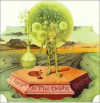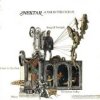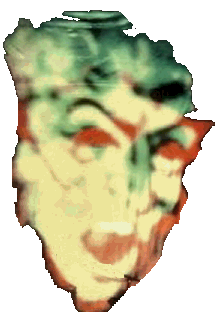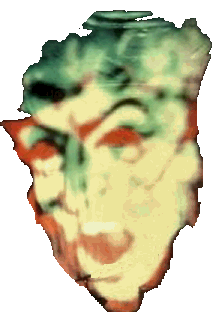
 A Tab In The Ocean
A Tab In The Ocean
(1972 United Artists UAS 29499)
Remastered (2004 Eclectic Discs DNECD 1201)
|
Roye Albrighton / guitar, lead vocals
Derek "Mo" Moore / bass, backing vocals
Ron Howden / drums, percussion
Allan "Taff" Freeman / keyboards, backing vocals
Mick Brockett / lighting, projections and visual effects
|
Concepts by Mo & Mick
Music by Roye, Taff, Mo & Ron
Lyrics by Roye, Mo & Mick.
A NEKTAR composition.
|
the Original German mix
|
*the Re-mastered 1976 U.S.A. Mix
|
mp3 samples are red buttons
|
** Larry Fast not only added his Magic to the sound of the U.S. mix, Larry assisted Mo in the re-mastering process!
|
"An awesome follow-up to the classic debut. The album starts with the 17–minute
title track, which got a atmosphere that fits the title quite good. The track sounds
like it was recorded in a big hall, with Nektar on one side of the hall, and the
recording–equipment on the other side. I think this production gives the track a
very powerful sound. Great themes, and all the other stuff you want from a composition
of this length. The rest of the album is almost heavy–progressive, but with the
typical Nektar–sound. "Desolation Valley" is quite genius with its simplistic,
but extremely powerful and effective riffs. The build up of this song is just great.
"King of Twilight" is another classic. Stated simply: an excellent album,"
Tommy Shoenbergs.

|
the King Of Twilight
|

|
The rapid assembly of the "Space-Opera side one" plus the "Dream
Nebula" in 1970 had stalled, so "Good–day" or "New Day Dawning"
became our temporary ending to it at live concerts. This was all somewhat due to
our second "project" growing into an entity of its' own alongside
Journey in 1970. Both projects later came together in one medley… and poor Stig
(remember him?) performed a re–entry to Earth to crash deep into Desolation Valley
(the Ocean) rather than being abducted to the Dream Nebula! We performed many variations
of "Journey to Desolation" but a VERY rare combo of just Astronauts Nightmare
into Desolation Valley was probably our shortest. Later versions used Desolation
Valley to replace the Dream Nebula after "Warp", because the opening notes
to both were so similar.
When the title "Desolation Valley" was changed from "Porcelain Valley",
only that one word and a small part of the lyrics (with reference to the "Great
Flood"?) were different, that was also the time that it became permanently
attached to the calming instrumental piece…. "Waves".
The foundation for "A Tab in the Ocean" was established long before most
of the lyrics were written, other than Roye's "Falling" (from 1970)
which became incorporated into this piece before it even had a name. On the forum
we presented a "karaoke" version from September 1972, JUST before the
Tab studio sessions when it had very few permanent lyrics. Mo & I wrote more
lyrics in hotel rooms, probably based on that very tape, the rest were penned at
Dierks studio two weeks later. The stage was liquid green, purple and blue… in pulsating
order, and those sitting close to the stage on blankets and pillows were immersed
IN it all.
By 1972, Keith was with me, operating slides of Viking, sailing and steam ships,
a guy in a bathtub, whales, the octopus, a fight with the submarine, and the sunsets…
which played out our second audio/visual "made for the screen" Nektar
show after "Journey". "The one that got away" usually refers
to a fish…. but in this case it was an entire piece titled "We are the Ocean"…
another track that never made it anywhere… once it was shelved in 1971. A practice
tape and a few live recordings of it became the only surviving remnants, so that
YOU could experience (as I did) the same wonder of just how prolific Nektar WAS
in 1971. Taff and Roye put the melody together, and with Mo and Ron driving this
(submarine?) piece, it was killer!… I had designated the idea of looking through
the eyes of a killer shark or dolphin to depict speed during its' possible visual
translation on the screens, or as if the view was from a torpedo. This piece deserved
a reincarnation!
Getting back to side two of Tab…. as said, "Desolation Valley" underwent
many changes before the final album version, it was often jazzier, retained three
separate titles and diverse lyrics throughout 1971. The heavy verse we later used
to open side two of Tab was buried far deeper into early versions, preceded by the
quieter, jazzier verse, yet Winds of time, sailing minds, sunsets, trees, were all
there… in "Porcelain Valley"… This is why live liquids worked so well
with early Nektar, there was so much spontaneous jamming …especially when we were
playing to our growing local fan base around Darmstadt, who also saw how it had
evolved from "Acorn Valley".
I must admit, I would loved to have heard the earlier jazzy variation recorded with
the much later album lyrics. First called "The 5/4 piece" because the
initial jam back in 1970 WAS in 5/4 time inspired by Brubeck's "Take Five"
and we had been playing this jazzy jam for a few months, it had become longer and
longer, with a contrasting 4/4 verse, …then with repeated verses and more solo areas,
until it morphed into more of a 4/4 piece… still instrumental… THEN some impromptu
vocals emanated from our liquid stage… "See the sunny sand, walking on the
(something), see the sunny winters night, you broke your shoe?, see the way you
found her way, (something, something), see how many acorns break" (you go figure),
then back to the instrumental with interesting guitar interludes, still within that
delicate "Take Fivish" rhythm. THAT version is now back in the archives.
Crying in the Dark has always been called the "D–jam" on set–lists since
it premiered as a pure instrumental jam in 1971. It has been a jam ever since too,
as the opening was a typical live check for tuning as Ron slams the snare to get
the attention of everyone. Taff's Hammond melody became more refined, yet still
loose enough to play around with, … then Roye's counter solo brought his wah–wah
into play to make it different. The "D jam" became a permanent link to
"King of Twilight" … tough on all vocal chords, even back in 1972, when
important harmonies throughout this song had to be on the money ….because this piece
drives like crazy, right to the very last "Free". Mick
Brockett.© 2010
Editor's note: Nektar developed a song called "We
Are The Oceans" for concerts during their early years that had a watery theme
which would have fit right in with a "Tab In the Ocean" theme, however,
due to the time limit constraints of Vinyl albums "We Are The Oceans"
was left off this excellent release.